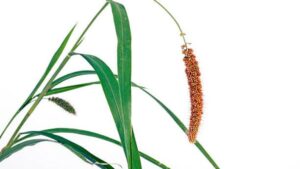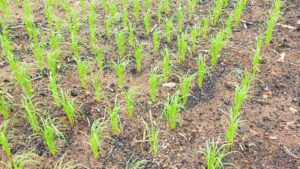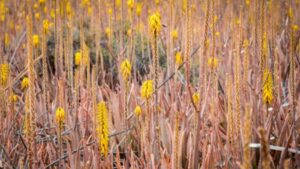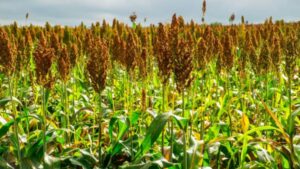Brown top millet, a powerhouse of nutrition and economic potential. In this Article, we will delve into the intricacies of cultivation, growth stages, environmental considerations, harvesting techniques, nutritional benefits, economic and environmental advantages, and much more.
Brown Top Millet Overview

Brown top millet, scientifically known as Urochloa ramosa, is a small-grain cereal crop that is gaining popularity for its adaptability, resilience, and nutritional richness. Before we embark on the cultivation journey, let’s understand why brown top millet deserves a place in your agricultural endeavors.
It is a gluten-free grain with a nutrient profile that includes essential vitamins, minerals, and protein. Its versatility extends from culinary applications to animal feed and even industrial uses, making it a multifaceted crop for farmers.
Cultivation of Brown Top Millet
Choosing the Right Location
Selecting an appropriate location for brown top millet cultivation is the foundation of success. Ideally, choose well-drained soils with good sunlight exposure, typical of warm climates. Consider regions with a temperature range of 25-35°C for optimal growth.

Soil Preparation and Requirements
Proper soil preparation is key to maximizing yield. Start by plowing the land to a depth of 6-8 inches to ensure loose soil for root development. Conduct a soil test to identify and address any nutrient deficiencies, and aim for slightly acidic to neutral soils.
Optimal Planting Time and Conditions
Timing is crucial. The warm season is optimal for planting brown top millet. Aim for a planting depth of 1-2 inches and maintain adequate moisture during the initial stages. Good soil moisture and warmth contribute to successful germination.
Seed Selection and Sowing Methods
Choose high-quality seeds from reputable sources. Direct sowing or transplanting can be employed based on regional preferences and available resources. Maintain a seeding rate of approximately 5-10 lbs per acre for optimal results.
Growth Stages

Germination and Early Growth
Once the seeds are sown, the germination stage begins, typically within 5-10 days. shows rapid early growth, establishing a robust foundation for the upcoming stages. During this phase, ensure consistent moisture and weed control.
Vegetative Stage
The vegetative stage is characterized by leaf and stem development. Provide adequate nutrients, especially nitrogen, to support vigorous growth. Water management is crucial during this phase to avoid water stress, which can impact overall development.
Flowering Stage

As the plant matures, it enters the flowering stage, marked by the emergence of panicles. This phase is critical for grain development. Monitor for pests and diseases, and provide supplementary irrigation if needed.
Maturation and Ripening
The final stage involves maturation and ripening of the grains. Monitor the crop closely, as the timing of harvest significantly impacts the quality and yield. Harvest too early, and grains may not be fully developed; harvest too late, and the crop may suffer losses.
Environmental Considerations
Drought Tolerance
Brown top millet is renowned for its exceptional drought tolerance, making it a resilient choice for arid regions. However, this doesn’t mean neglecting water needs entirely. While the crop can withstand dry periods, providing supplemental irrigation during prolonged droughts ensures optimal growth and yield.
Pest and Disease Management

A vigilant approach to pest and disease management is crucial for a successful harvest. Common pests include grasshoppers and aphids, while diseases such as blast and smut can affect the crop. Implement integrated pest management strategies, including biological control methods and resistant varieties, to safeguard your crop.
Fertilization Needs
Balanced fertilization is key to enhancing the nutrient profile of brown top millet. Apply nitrogen-rich fertilizers during the vegetative stage, phosphorus for root development, and potassium for overall plant health. Conduct soil tests regularly to adjust fertilization based on specific soil requirements.
Harvesting Brown Top Millet
Determining the Right Time for Harvest
Timing is a critical factor in harvesting millet. Typically, the crop is ready for harvest 60-90 days after planting. The key indicator is when the panicles have turned golden-brown, and grains are hard and firm. Harvesting too early can lead to immature grains, affecting quality and yield.
Harvesting Techniques
Selecting the right harvesting technique ensures minimal losses and preserves grain quality. Common methods include combine harvesting or hand harvesting with sickles or scythes. Adjust equipment settings to avoid shattering of grains during the process.
Post-Harvest Processing

Post-harvest processing is essential to maintain the nutritional value of millet. Thresh the harvested grains to separate them from the stalks. Proper drying and storage in well-ventilated areas prevent mold and insect infestations.
Nutritional Benefits
Nutrient Profile of Brown Top Millet
Brown top millet boasts a nutrient-rich profile, containing essential vitamins, minerals, and macronutrients. It is a good source of iron, zinc, magnesium, and B vitamins. The high fiber content aids digestion, making it a valuable addition to a balanced diet.
Here’s an table with a more detailed breakdown of vitamins and minerals for Brown Top Millet per 100 grams:
| Nutrient | Amount | % Daily Value* |
|---|---|---|
| Calories | 378 kcal | |
| Protein | 11 g | |
| Carbohydrates | 73 g | |
| Dietary Fiber | 8.5 g | |
| Fat | 4 g | |
| Vitamins: | ||
| – Vitamin B1 (Thiamine) | 0.1 mg | 7% |
| – Vitamin B2 (Riboflavin) | 0.1 mg | 5% |
| – Vitamin B3 (Niacin) | 4.7 mg | 24% |
| – Vitamin B5 (Pantothenic Acid) | 1.5 mg | 15% |
| – Vitamin B6 | 0.4 mg | 20% |
| – Folate (B9) | 8 mcg | 2% |
| – Vitamin E | 1.5 mg | 8% |
| Minerals: | ||
| – Calcium | 17 mg | 2% |
| – Iron | 3.9 mg | 22% |
| – Magnesium | 114 mg | 29% |
| – Phosphorus | 285 mg | 29% |
| – Potassium | 195 mg | 6% |
| – Sodium | 5 mg | 0% |
| – Zinc | 2.8 mg | 19% |
Health Benefits for Humans and Animals
For humans, millet offers a gluten-free alternative, making it suitable for individuals with gluten sensitivities. Additionally, its protein content contributes to muscle development and overall well-being. When used as animal feed, it promotes healthier livestock, enhancing the quality of meat and dairy products.
Economic and Environmental Benefits
Economic Viability of Brown Top Millet Cultivation
The economic prospects of millet cultivation are promising. The crop’s versatility allows for various revenue streams, from selling grains for human consumption to supplying animal feed. Additionally, its short growth cycle minimizes input costs, contributing to overall profitability for farmers.
Environmental Sustainability
Brown top millet’s adaptability to different climates and minimal environmental impact align with sustainable agricultural practices. Its drought tolerance reduces the need for excessive irrigation, contributing to water conservation. Incorporating millet into crop rotations also enhances soil health.
Brown Top Millet in Different Regions
Adaptability to Various Climates
Brown top millet’s adaptability to diverse climates makes it suitable for cultivation in various regions. From tropical to subtropical climates, this crop showcases versatility, allowing farmers to explore its potential across different environments.

Regional Success Stories
Exploring successful cultivation stories in specific regions provides valuable insights. In India, for example, millet has shown success in states like Rajasthan, known for its arid conditions. Farmers in these regions have embraced millet for its resilience and economic benefits.
Challenges in Cultivation
Common Issues Faced by Farmers
While brown top millet is a resilient crop, farmers may encounter common challenges. Weeds, particularly during the early growth stages, compete for nutrients and moisture. Additionally, pest infestations, such as grasshoppers and aphids, can impact crop health. Addressing these challenges promptly is crucial for a successful harvest.
Solutions and Best Practices
Implementing effective solutions and adopting best practices can mitigate challenges in millet cultivation. Integrated pest management, timely weeding, and using resistant varieties are essential practices. Moreover, maintaining proper soil fertility through regular testing and balanced fertilization enhances the crop’s resilience.
Popular Uses of Brown Top Millet
Culinary Applications
Brown top millet is a versatile ingredient with various culinary applications. It can be ground into gluten-free flour for baking or used in porridge and couscous dishes. Its mild, nutty flavor makes it a favorite in diverse recipes, offering a nutritious alternative to conventional grains.
Animal Feed
The nutritional richness of millet makes it an excellent choice for animal feed. It provides essential nutrients for livestock, promoting overall health and productivity. Including brown top millet in animal diets can enhance the quality of meat and dairy products.
Other Industrial Uses
Beyond traditional uses, brown top millet has potential industrial applications. Its starchy composition makes it suitable for biofuel production, offering a renewable and eco-friendly alternative. Exploring such applications opens new avenues for economic diversification.
Case Studies
Examples of Successful Brown Top Millet Farms
Real-world success stories inspire and educate. In Maharashtra, India, farmers have embraced brown top millet cultivation in rainfed areas. The crop’s ability to thrive in low-input conditions has significantly improved the livelihoods of these farmers, showcasing the crop’s adaptability and economic benefits.
Future Prospects
Potential Advancements in Cultivation
Ongoing research and technological advancements hold the key to unlocking further potential in brown top millet cultivation. Researchers are exploring methods to enhance drought resistance, improve yield, and develop new varieties tailored to specific climates. Staying updated on these advancements can empower farmers to adopt cutting-edge practices.
Emerging Markets and Opportunities
As awareness of brown top millet’s nutritional benefits grows, new markets and opportunities emerge. The demand for gluten-free and nutrient-rich foods continues to rise, creating avenues for farmers to explore value-added products. Collaborations with health-conscious food industries can open doors to diverse markets.
Conclusion
Cultivating brown top millet is a journey filled with possibilities. From its adaptability to diverse climates to its economic and nutritional benefits, this crop stands as a testament to sustainable agriculture. Embrace the knowledge gained from this comprehensive guide to embark on a successful brown top millet cultivation venture.
Frequently Asked Questions (FAQs)
What makes brown top millet a suitable crop for cultivation?
Brown top millet’s adaptability, nutritional richness, and economic viability make it an attractive choice for cultivation.
Are there any specific regions where brown top millet thrives better?
Brown top millet thrives in warm climates with well-drained soils, making it suitable for regions with temperatures ranging from 25-35°C.
How can farmers address common challenges in brown top millet cultivation?
Farmers can address challenges through integrated pest management, timely weeding, and maintaining proper soil fertility. Adopting best practices enhances crop resilience.
What are the primary nutritional benefits of consuming brown top millet?
Brown top millet is a rich source of essential vitamins, minerals, and protein. It offers a gluten-free alternative, promoting overall health for humans and animals.
How can one contribute to the sustainable cultivation of brown top millet?
Sustainable cultivation involves efficient water management, adopting eco-friendly practices, and staying informed about advancements in cultivation techniques.
What is brown top millet used for?
Brown top millet is used for diverse purposes, including human consumption, animal feed, and potential industrial applications.
What is the Indian name for brown top millet?
In India, brown top millet is commonly known as “Korale” or “Bhagar” in regional languages.
How fast does brown top millet grow?
Brown top millet exhibits rapid growth, typically reaching maturity within 60 to 90 days after planting.
Greenery
Fragrance Of Life
